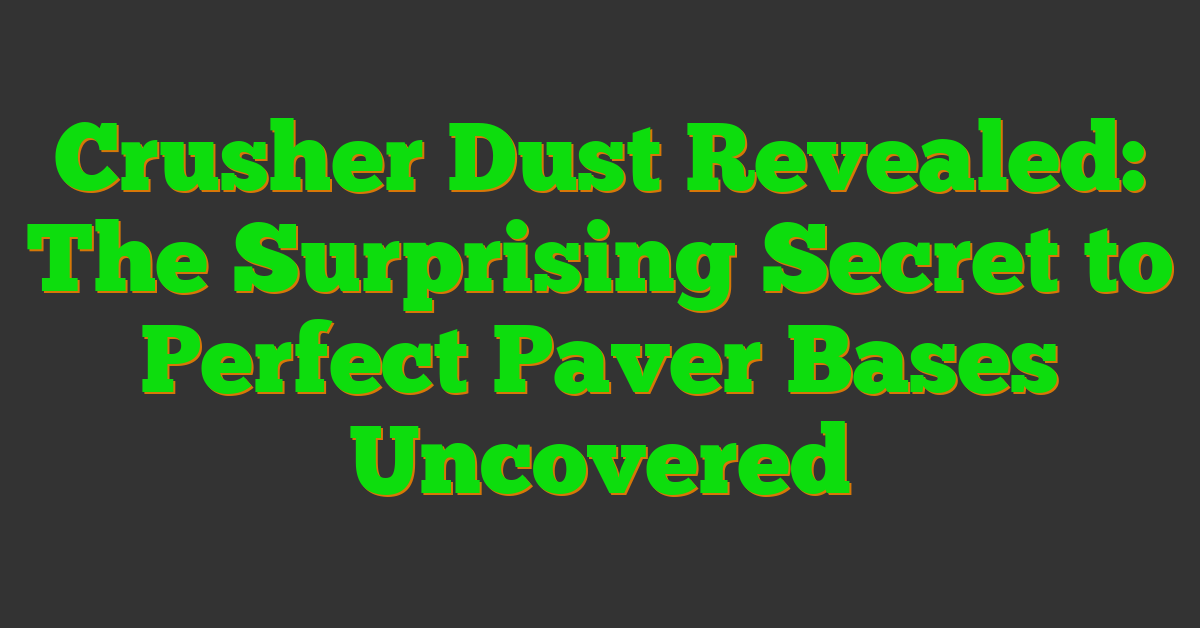When it comes to laying pavers, choosing the right base material is crucial for the longevity and stability of your project. One common option that DIY enthusiasts and professionals consider is crusher dust. But is crusher dust a reliable choice for paver bases? In this article, we’ll explore the pros and cons of using crusher dust as a base for your pavers.

We’ll delve into the key factors to consider when deciding whether crusher dust is suitable for your paver project. From its effectiveness in providing a solid foundation to its potential drawbacks, we’ll provide you with the information you need to make an informed decision. So, before you start your next paver installation, join us as we uncover the truth about using crusher dust as a base material.
Understanding Crusher Dust in Paving Projects
As landscape designers, we often contemplate the suitability of crusher dust as a base material for paving projects. Let’s delve into the characteristics of this material to better understand its potential application in such endeavors.
What Is Crusher Dust?
In our landscaping projects, crusher dust, also known as quarry dust, is a byproduct of crushing stone. This fine material is typically used as a compacting base for interlocking pavers and concrete slabs. Its composition consists of finely crushed rock and stone dust, forming a strong and stable foundation when compacted.
Properties of Crusher Dust
When considering crusher dust for paving bases, understanding its properties is crucial. This material is known for its excellent compaction properties, making it ideal for creating a solid base for various outdoor surfaces. Additionally, its ability to interlock tightly when compacted ensures a durable and long-lasting foundation for pavers.
Incorporating crusher dust in paving projects offers benefits such as improved drainage due to its permeable nature. This characteristic helps prevent water pooling, promoting the longevity of the paved surface. Furthermore, the fine granular texture of crusher dust facilitates a stable bedding layer that supports the pavers evenly.
By recognizing the properties of crusher dust, we can make informed decisions on utilizing this material effectively in our paving projects.
Comparing Crusher Dust to Other Paving Bases
Crusher Dust vs. Sand: Which Is Better?
When comparing crusher dust to sand as a paving base, we find that both have their advantages. While sand is a popular choice due to its availability and affordability, crusher dust offers distinct benefits that make it a favorable option for paver bases.
Sand:
- Advantages:
- Widely available and cost-effective.
- Easy to work with during installation.
- Provides good leveling properties.
Crusher Dust:
- Advantages:
- Offers excellent compaction properties, creating a stable base.
- Helps improve drainage, reducing the risk of water buildup under pavers.
- Acts as a reliable bedding layer, preventing shifting and promoting long-term durability.
When considering the choice between sand and crusher dust for your paving project, it’s essential to assess factors such as compaction, drainage, and stability to determine the most suitable option for your specific needs.
Crusher Dust vs. Gravel: Strength and Durability
In the comparison of crusher dust to gravel for paver bases in terms of strength and durability, both materials have distinct characteristics that impact their performance in paving installations. While gravel is a traditional choice known for its strength, crusher dust offers unique advantages that contribute to long-lasting and stable paver bases.
Gravel:
- Characteristics:
- Known for its strength and load-bearing capacity.
- Provides good drainage due to its permeable nature.
- Can shift over time, requiring periodic maintenance.
- Characteristics:
- Exhibits excellent compaction properties, ensuring a solid base.
- Enhances drainage by allowing water to flow through the material.
- Offers long-term stability, reducing the need for frequent adjustments.
When evaluating the suitability of crusher dust versus gravel for your paving project, consider factors such as compaction, drainage improvement, and long-term stability to determine the most suitable material for achieving a durable and resilient paver base.
Pros and Cons of Using Crusher Dust as a Base
Advantages of Crusher Dust for Pavers
As landscape designers, we know that using crusher dust as a base for pavers offers several advantages that can enhance the quality and longevity of your project.
- Excellent Compaction Properties: One of the key benefits of crusher dust is its ability to compact well, providing a stable base for your pavers. When properly compacted, crusher dust creates a solid foundation that can support heavy loads without shifting.
- Effective Drainage Improvement: Crusher dust allows for adequate drainage, preventing water from pooling on the surface of your pavers. This feature helps maintain the integrity of the base by reducing the risk of erosion and water damage over time.
- Enhanced Stability: The compact nature of crusher dust contributes to the overall stability of your paver surface. With its firm base, crusher dust minimizes movement and settlement, ensuring your pavers stay level and secure.
- Cost-Effective Option: In addition to its performance benefits, crusher dust is often a more cost-effective option compared to other base materials. Its affordability makes it an attractive choice for both small and large-scale paving projects.
Potential Drawbacks to Consider
While crusher dust offers various advantages, there are also some potential drawbacks that you should take into account before choosing it as a base for your pavers.
- Dust Concerns: As the name suggests, crusher dust can create dust particles during the installation process or when disturbed. This dust may pose a cleanliness issue and require regular maintenance to keep your paver area looking neat.
- Compaction Challenges: Achieving optimal compaction with crusher dust may require special attention during installation. Improper compaction can lead to stability issues over time, affecting the performance of your pavers.
- Moisture Absorption: Crusher dust has the potential to absorb moisture, which can impact its compaction properties and overall stability. Excessive moisture absorption may result in a less durable base that requires more frequent maintenance.
- Professional Application Recommended: Due to its specific characteristics, using crusher dust as a base material may require professional expertise to ensure proper compaction and installation techniques.
Considering these pros and cons of using crusher dust as a base for your pavers, it’s essential to weigh the benefits against the potential drawbacks based on your project requirements and preferences.
Installation Tips for Crusher Dust Base
Preparing the Ground
When it comes to preparing the ground for a crusher dust base, our focus is on ensuring a stable and solid foundation for your pavers. We start by clearing the area of any debris, vegetation, or existing materials that could interfere with the base’s integrity. It’s essential to have a clean and level surface to achieve optimal compaction and stability.
Next, we compact the soil using a compactor to create a firm base for the crusher dust. Proper compaction is crucial as it prevents settling and ensures uniform support for the pavers. We pay special attention to the edges and corners to avoid any weak spots that could compromise the overall structure.
Laying and Compacting Crusher Dust
When laying crusher dust as the base for your pavers, our approach is meticulous to guarantee a durable and long-lasting foundation. We evenly spread the crusher dust across the prepared area, making sure to maintain a consistent thickness to promote even compaction.
Using a compactor, we compact the crusher dust in layers, gradually building up the density to enhance stability. This step is critical for achieving the desired level of compaction, which is key to preventing shifting or settling of the pavers over time.
Throughout the process, we monitor the compaction levels to ensure uniformity and adequacy. By following proper techniques and paying attention to detail, we can create a reliable base with crusher dust that offers superior compaction, improved drainage, and lasting stability for your paver project.
« Surprising Secrets Revealed: Discover How Long Pavers Really Last! 😲🔥 PaverPermanence OutdoorOasis Discover the Ultimate Secret to Prolonging Your Pavers: Should You Seal Them? Unveiling the Truth »
Maintaining Your Crusher Dust Paver Base
Periodic Checks and Adjustments
When it comes to maintaining your crusher dust paver base, periodic checks and adjustments are key to ensure its longevity and performance. As landscape designers, we recommend regular inspections of the paver base to identify any issues promptly.
Ensuring that the crusher dust base remains even and compact is essential for the stability of the pavers above. We suggest walking over the paver area periodically to detect any unevenness or settling. If we notice any dips or bumps, we can address them promptly by adding more crusher dust and compacting the area again.
Another crucial aspect of maintenance is addressing any weed growth that may occur between the pavers. Weeds not only detract from the aesthetics but can also destabilize the pavers if left unchecked. Our recommended approach is to manually remove weeds as soon as they appear to prevent them from taking root and causing damage.
Long-Term Care Strategies
To ensure the long-term durability and stability of your crusher dust paver base, implementing effective care strategies is vital. As experienced landscape designers, we advocate for proactive measures to preserve the integrity of the base over time.
One essential long-term care strategy is to replenish the crusher dust layer periodically. Over time, the base may experience natural settling and erosion due to weather elements and foot traffic. By adding a thin layer of fresh crusher dust and compacting it, we can restore the base’s compaction and support for the pavers.
Additionally, we advise homeowners to consider applying a sealant over the paver surface to protect both the pavers and the underlying crusher dust base. A quality sealant can help prevent water penetration, weed growth, and erosion, enhancing the longevity of the entire paver installation.
By incorporating these maintenance practices into your routine, you can ensure that your crusher dust paver base remains reliable and sturdy, providing a solid foundation for your outdoor living space.
Conclusion
Crusher dust emerges as a superior option for paver bases due to its excellent compaction, drainage benefits, and overall stability. While it presents some challenges like dust concerns and compaction issues, the advantages outweigh the drawbacks. By following the maintenance tips provided, we can ensure a long-lasting and durable paver base that enhances outdoor living spaces. With periodic checks, consistent compaction, weed control, and strategic care methods, our crusher dust base will remain reliable and sturdy. Choosing crusher dust as a base material for pavers is a smart decision that can lead to a well-maintained and resilient outdoor area for years to come.











